Among the most critically-acclaimed “period drama” TV series in recent memory is the British production, Downton Abbey. While many love the show as a whole (ourselves included!), we’re taking a closer look at its menswear today, to analyze if the ensembles depicted are historically accurate or not.
- A Brief Introduction to Downton Abbey
- Menswear Expert’s Review of Downton Abbey: Character Analysis
- Lord Grantham/Robert Crawley (Played by Hugh Bonneville)
- Matthew Crawley (Played by Dan Stevens)
- Tom Branson (Played by Allen Leech)
- Downton Abbey’s Dress Codes: 1. Morning Wear
- 2. Evening Ensembles (Black Tie & White Tie)
- Hats: 1. Top Hats
- 2. Fedora Hats
- 3. Bowler Hat
- 4. Boater Hats
- An Interesting Menswear Detail: Pleats
- Conclusion
- Outfit Rundown
A Brief Introduction to Downton Abbey
Downton Abbey is the fictional Yorkshire estate from which the show takes its name. The show follows the lives of the Crawley family headed by Lord Grantham, the seventh Earl of Grantham. The show mainly takes place inside Downton Abbey, which is, in fact, the Highclere Castle.
If they were a modern family, perhaps they’d be wearing slippers, hoodies, and sweatpants. But, back then, clothes were a lot more formal. Depending on the event, the people who are visiting, and the time of day, people might have changed clothes multiple times in a single day.

As menswear enthusiasts, we’re treated with morning wear, evening wear, hunting wear, regular day wear, and all sorts of details that are just wonderful and rarely seen on TV shows these days anymore.
The costumes of Downton Abbey were so popular that they themselves toured the world. Designer Anna Robbins said that historical accuracy was extremely important to her so that the costumes could withstand scrutiny on screen and in real life.

She also said that Downton Abbey was head and shoulders above other shows and the efforts she went to to ensure everything was as accurate as it could be. She also mentioned that she tried her best to get true period pieces from Paris, London, and elsewhere, but I think she referred more to womenswear.
The gentlemen in the show mostly wore bespoke items because they felt they couldn’t really get the items in the right size for the people they had on set.

I’ve watched the entire show several times with my wife, and from our impression, it seems like it’s mostly bespoke, but there are also some period costumes in the show. Overall, the show had four different costume designers, and they worked along with Alastair Bruce, the historical advisor from 2010 to 2012.
Frankly, unlike most American productions, Downton Abbey is a lot more meticulous in details. But, of course, they don’t get everything right. Again, it’s impossible to catch every detail, but they really tried their best.

The biggest issue they had in regards to menswear was the fabrics. Modern fabrics are finished differently. They’re typically lighter, and they don’t drape as well as the original old fabrics. As a consequence, some of the suits and outfits look far too modern for the trained eye. And while they might be vintage, they’re just not accurate for the time they’re portraying in the series.
Menswear Expert’s Review of Downton Abbey: Character Analysis
So, let’s first look at some important male characters of the show, and what they wore, what was accurate and what was not, and then, let’s switch over to specific items, such as morning wear or evening wear or headwear, and discuss what they got right and what they got wrong.

Lord Grantham/Robert Crawley (Played by Hugh Bonneville)
We kick off our review with Lord Grantham, Robert Crawley, the seventh Earl of Grantham. As an aristocrat from a long line of earls, you would expect him to be well-versed in anything relating to social etiquette and a proper wardrobe. In fact, he had a valet who would help him get dressed and make sure that his outward appearance is always stellar.
At the time, your wealth wasn’t displayed by the amount of bling, jewelry, or fur you had. Instead, your rank in society was defined by your title, estate, and the number of staff you had. Also, your understanding of social and sporting etiquette was an important indicator of wealth. Because of this, Lord Grantham’s outfits are not flashy at all but are much rather conservative.

A man of his stature would display his wealth through the quality of his garments and the fabric, through the precise fit and the appropriateness of the clothing, for the different events and times of the day.
The First Suit We See on Lord Grantham
When we first see his lordship in season one, set in 1912, we see him from behind, and, generally, people wouldn’t think about it, but at the Gentleman’s Gazette, we pay great attention to detail. In fact, the look from the back gives us the first hint at a historical inaccuracy.

If we take a closer look at the shoulder seam, it’s rather modern, straight, and more on top of the shoulder. Whereas, back then, in 1912, the shoulder seam would have moved much further back, so you could never see it from the front. Interestingly, this mistake was not made on these servants’ uniforms. So, either they used original uniforms, or a vintage pattern.
Lounge Suit Ensemble
In another shot, you can actually see Lord Grantham wearing a lounge suit. How the term “lounge” and “suit” go together today in a world where the suit is considered a formal garment is explained in our History of the Suit guide.
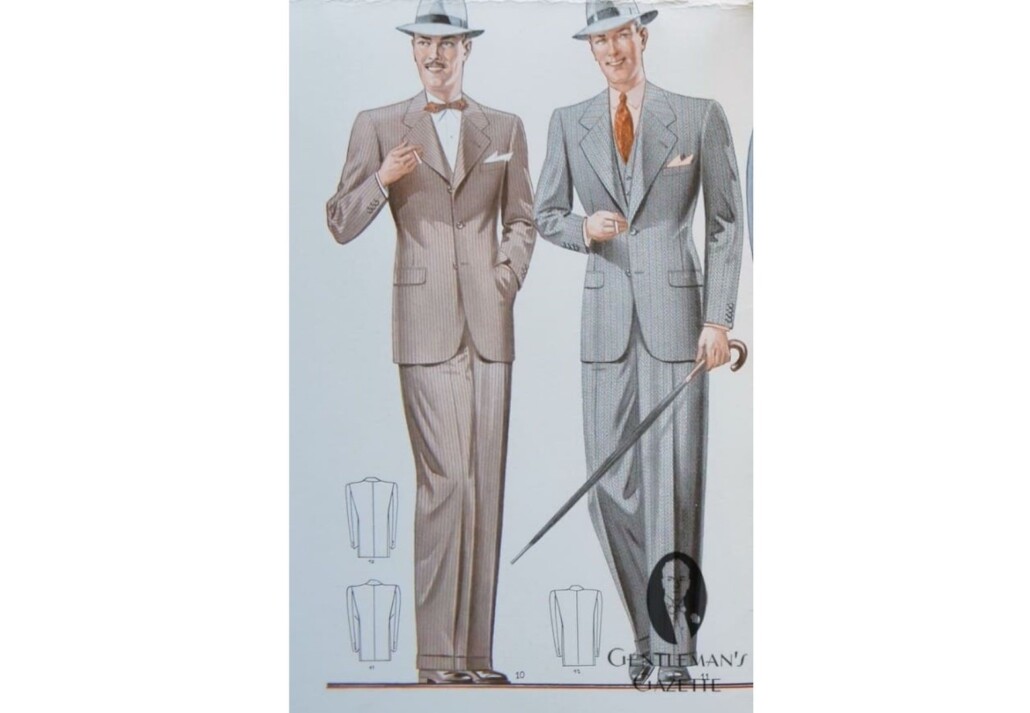
During that time, the lounge suit had already become the number one garment for everyday casual or non-formal wear among men. Overall, though, you can see some wrinkles here that are a good indicator that this was not a vintage suit, and an older suit would have just draped much more beautifully.

On close inspection, we can also see some details. For example, you have a slightly slanted buttonhole, and the cord to the lapel is not straight but angled. This is sometimes also known as the Knize lapel after the famous Viennese tailor Knize.
Moreover, the size and shape, and pattern of the silk tie are very accurate to the period. Squares and diamonds worn into silk were very popular, and he used a four-in-hand knot. The tie is held together by a tie stick pin, which, again, was popular at the time, and it was bold enough to stand out from the background but not overly extravagant.
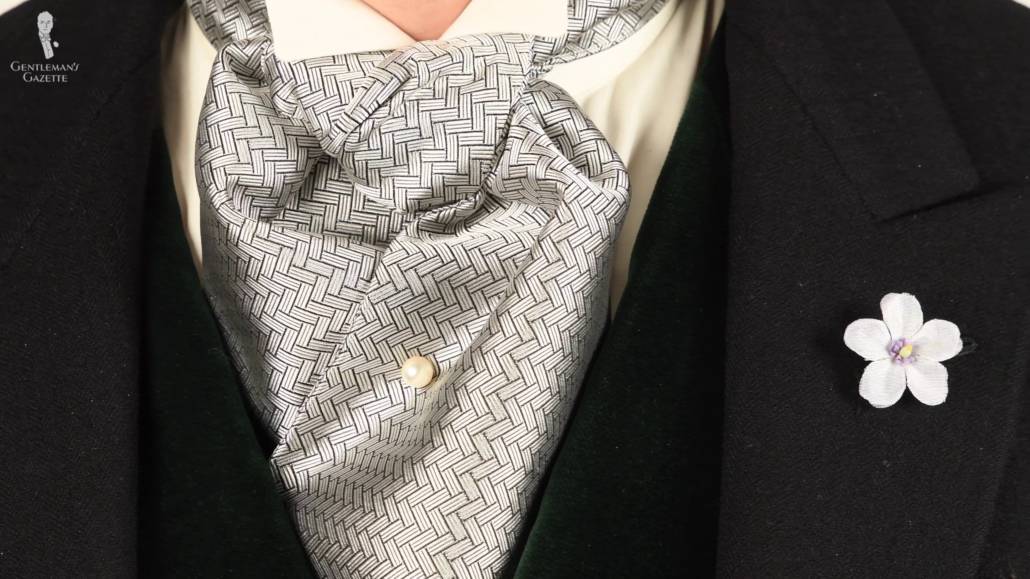
Lord Grantham’s Shirts & Collars
Unlike today, his shirt collar was stiff, starched, and detachable, and that’s what men wore during that time period. It’s worth noting, though, that in certain scenes, there’s something off with the shirt. Either the neckband on the shirt is too tall, or the collar is too large, but the fit isn’t 100% right.
Honestly, this is an issue of fit, not something that’s historically inaccurate. If you pay close attention, you can also observe this on the butler, Carson (played by Jim Carter).

Interestingly, Lord Grantham often wears a crisp, clean white shirt. And while you may not think much about it, back then, it was a status of wealth. Why? Because only the wealthy could afford to always have a newly-laundered, clean, starched white shirt.
Let’s compare these shirts to the ones from Mr. Bates (played by Brendan Coyle). He wears striped shirts, which were more popular with the working middle class because they showed dirt less than a pure white shirt. Of course, that’s also where the terminology “white collar” and “blue collar” came from.

The most obvious inaccuracy is probably the more modern cut of the shoulder. First, there’s too much padding, and second, they’re too roped to be period accurate. Frankly, it’s so much attention to detail that hardly anyone would notice. So, I can understand why they only try to get it so accurate and then just move on and get the show filmed.
Trousers
The proportions of the suit are certainly okay. They’re high-waisted pants with a flat front, which was important because, at the time, they did not have pleats yet. If you’re interested to learn more about pleated pants and if they should be worn today, we have a guide to pleated pants, which you’ll certainly find helpful.
Waistcoat
If you look at the waistcoat, it’s probably a little bit long for the time, and, probably, he would also have the bottom waistcoat button undone as that was the style introduced by Edward VII.

Accessories
You’ll probably also notice some chains hanging there on his waistcoat. That’s, in fact, a double Albert chain because on one end of the chain, you had your pocket watch on the other end, you had a key to turn the watch or some other accessory, sometimes a pencil, for example.
In the middle, your waistcoat had a separate hole with a T-bar that held the watch chain in place so it would drape accurately to the left and right.
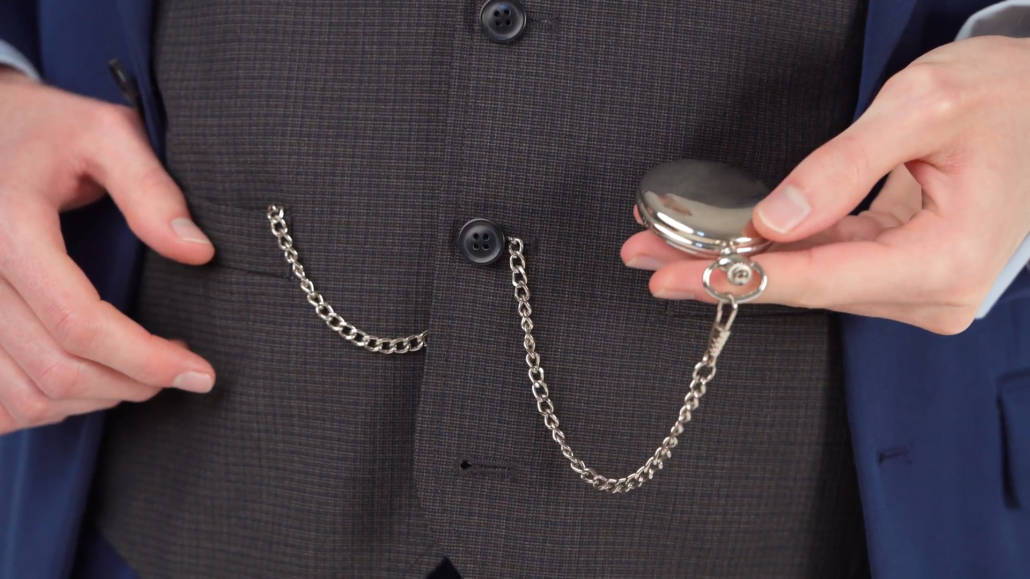
While any watch chain may look perfectly vintage to you, the watch chain he was wearing was probably a little bit too simple for a man of his standing. Someone in his position would have worn something a little more elaborate. Maybe he would have worn it with a fob, which was decorative and a sign of wealth. But, it was also a matter of personal taste.
You also notice that his pocket square isn’t folded in a particular crown fold. It was merely just tucked into their pocket as it was still a utilitarian thing that you could use to blow your nose to wipe something up and not just decorative.

Suit Cuff Stitch
One final detail that we’d love to see on a suit of that period was the cuff stitch. Not all suits at the time had the cuff stitch, but it was basically a stitch that was about 90 degrees to the sleeve, and it gave the appearance of a separate cuff.

That being said, the cuff buttons on Lord Grantham’s suits are definitely modern. The spacing would be much wider back in the day, and you may just have two buttons. Lord Grantham had a tighter spacing, which is more modern.
Astrakhan Collar Overcoat and Homburg Hat Outfit
In another ensemble, you can see on Lord Grantham an astrakhan collar contrasting to his overcoat and a nice homburg hat with an extreme brim curl, something that you have a hard time finding today in headwear.

Astrakhan is a curly lamb collar that was popular at the time. And also, you saw velvet collars on dark overcoats. The lapels are short and small and notched, which is period-accurate, and the fabric, even though it seems to be a solid, is in fact a small micro-check.
Back in the day, there was a much richer variety in subtle patterns in menswear fabrics. In my mind, the hat is the real winner here because it’s definitely more of a historical piece. If you pinch the crown of a homburg, some people call it a “lord’s hat.”

Brown Suit
Later on, you see Lord Grantham wearing a brown suit, which is quite accurate. If you look closely at the edge of the collar, you can see a prominent edge stitch. It was done by machine, and it was actually functional, unlike today, to create a very flat edge.

Also, the shoulders here are much more period-accurate. Today, it’s typically pick stitching, and it’s done by hand, sometimes in two-row if you have an Italian garment of a higher quality. Back then, it was really close to the edge and machined sewn. Note that less padding creates a smoother shoulder line.
Changes Throughout the Show
From a menswear enthusiast’s point of view, it’s a bit sad that Lord Grantham’s outfits don’t change too much throughout the show. Sometimes, he wears a nice summer suit, for example. But, overall, his style is very conservative and consistent.
It’s more or less the same cut, just in different fabrics. But, it really underlines his character as a traditionalist because why would you want to change if you are at the top of society?

We may have expected a bit more variety in his jackets throughout the seasons in terms of buttoning points, gorge height, and such little details. But, that’s not the case. Maybe, back then, his tailor would have advised him on such little things.
However, you will notice that his ties changed with time, and so do his shirt collars. Later on, he starts to wear more rounded collars, which were typical and became more popular between 1910 and 1920. Other male characters in the show changed a bit more.

For example, if we look at Lord Merton, you can see that in 1925, lapels are much wider. That’s not something you’d have ever seen in the 1910s or 1912. It’s really nice to see that the costume designers paid attention to that and made sure the clothes evolved with the people as they would have back in the day.
Matthew Crawley (Played by Dan Stevens)
Next up, let’s look at Matthew Crawley, who is next in line to be the Earl of Grantham. He’s, in fact, just a third cousin once removed from Lord Grantham, and his father was a doctor. And while today, that may be a prestigious profession, back then, it was considered to be definitely one or two steps below an earl.
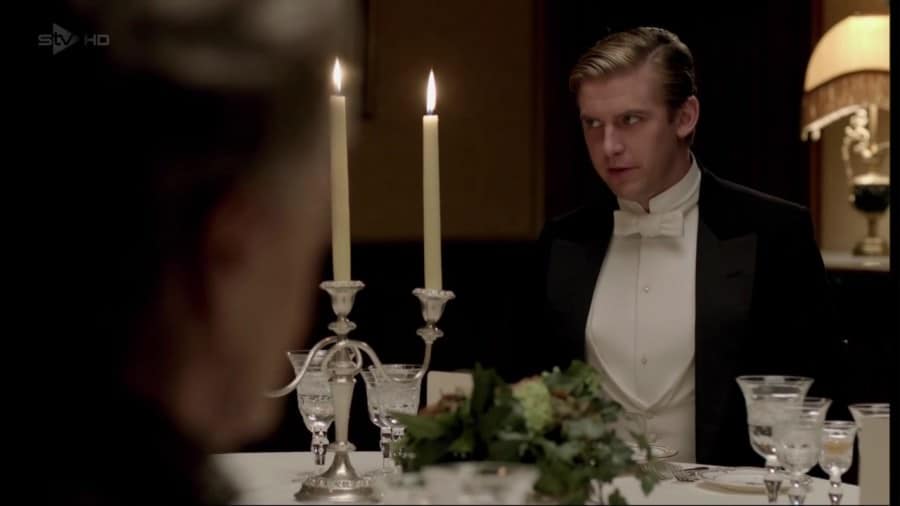
Crawley himself was a lawyer from Manchester before he moved to Downton. He actually has to work for his money even though his hands don’t get too dirty, putting him firmly into the middle class. Overall, I’d say he didn’t dress spectacularly, and his outfits have the same inaccuracies as Lord Grantham’s outfits.
Just like Tom, another young fella in the show, he typically wears softer shirt collars. For neckwear, he typically has a tie bar, which is typical for the era. Sometimes, you can also see him wearing lower or shorter rounded sport collars, but they are distinctly different from the collars Lord Grantham wears.

Double-breasted Suit
In season three, which is set in 1920, you can see Matthew Crawley wear a nice double-breasted suit, and I personally like it because you rarely see it in period dramas. Why? I don’t know. But they did it. In the 1920s, a button stance, which is the distance between the buttons, was not as much as it was, for example, in the 1930s.

Tom Branson (Played by Allen Leech)
Next, let’s talk about Tom Branson. Originally, the chauffeur of Lord Grantham. He’s a socialist, a republican, and, as the show starts, pretty much the antithesis to Lord Grantham. However, as the show progresses, he finds his way into the family as he marries the daughter Lady Sybil.
While, in the beginning, that is a scandal and everyone’s against it, the Crawley family comes to like and accept Tom into their family.

In terms of clothing, it’s interesting to note that Tom comes from a working-class background and, as such, he doesn’t wear these typical starched, high collars that Lord Grantham does. Instead, Tom wears soft collars that are made of cotton rather than starched linen.
However, these collars were still detachable. Why, you might wonder? Well, someone figured out that by removing just the collars, maybe also the cuffs, and just washing those, you had a lot less work than washing the entire shirt. At this time, a straight, tightly closed collar spread was the norm. Because the collar was soft, it might actually curl and stand up.
To prevent this, you wore collar pins or collar bars. Men like Tom would wear the collar bar or the collar clip to hold everything together neatly around the tie knot. It was really common among working and middle-class men, not so much the upper class because they had their starched collars that didn’t need this type of support.
One criticism we have for Tom is that his collar pin is typically worn too low and not close enough to his tie knot.
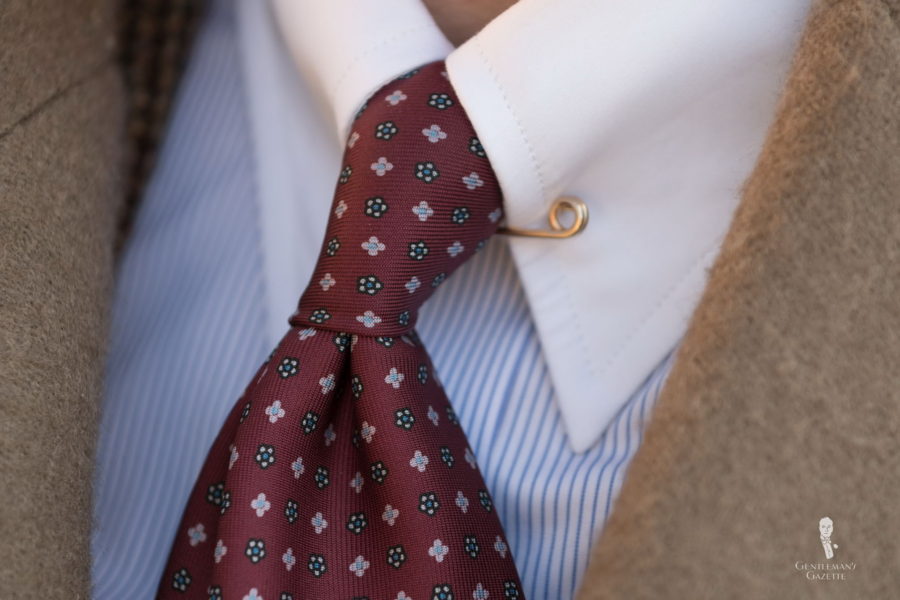
Change in Status + Change in Clothes
Along with his rise in status, you can also see a change in clothes. In the beginning, you rarely see him wearing suits but rather separates because that’s more appropriate for his working-class background.
However, one of his jackets worn in season two is one of the most historically accurate jackets. It has a cutaway front, four buttons in a single-breasted silhouette, and nicely slanted pocket flaps. Frankly, this style is more 1900s than 1910s, but because he was from the working-class, maybe it was a hand-me-down. Or maybe, they just didn’t pay close enough attention!

Later on, once Tom has joined the family, you can see him wearing three-piece suits and not the separates anymore, which corresponds with his rise in status, not class, though. Unfortunately, his suits look rather boxy and don’t have that trim, slim silhouette that he would have expected from the 1920s.
Sometimes, though, his jackets feature an ‘action back,’ which is a sport or country wear feature, and that is historically accurate.
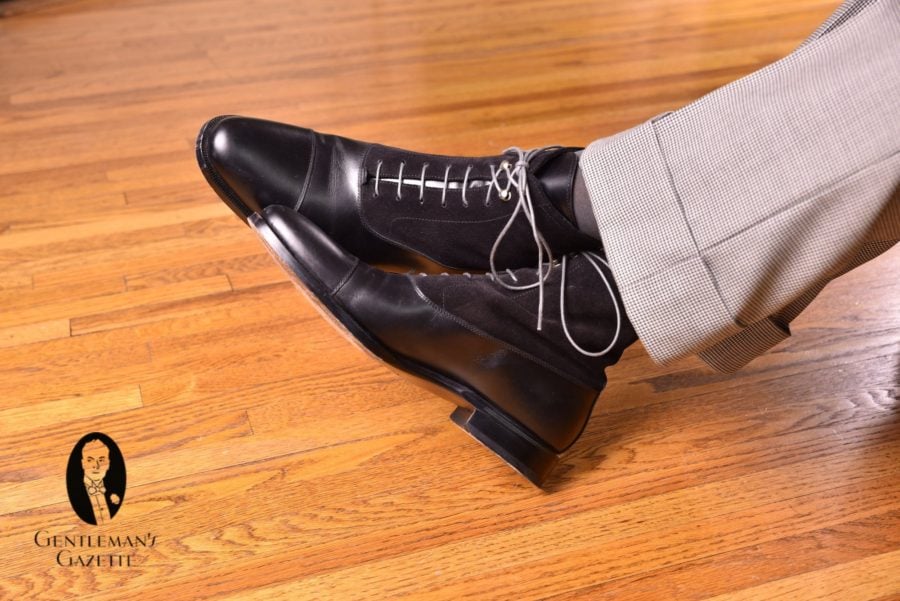
You’ll also see him wearing such things as a tweed suit with brown Balmoral boots, and while they were popular at the time, the ones he’s wearing look a bit too modern. The lace was different back then, and, especially, the stitching was a lot finer.
Downton Abbey’s Dress Codes: 1. Morning Wear
Matthew Crawley
Let’s start with a blunder. Matthew Crawley is actually wearing mourning attire because he’s mourning the death of his fiancée, Lavinia Swire. The issue, though, is that he wears what appears to be a 1930s shank-style morning coat. That means that, rather than having a single button, you had a shank that created more symmetry, and it opened up the coat more to show more of your waistcoat and your tie. This detail was definitely popular later on, and it wasn’t around in 1918. However, piping was present.

Sir Richard Carlisle (Played by Iain Glen)
Speaking of piping, similarly, Sir Richard Carlisle has a morning coat with nice piping but super wide lapels. Personally, I have an original morning coat from the 19-teens from America, but it also has a nice silk piping.

Super wide lapels are definitely a sight of the 1930s, because the ’20s were trimmer and neater. Also, morning garments at the time still had these damask woven fabric-covered buttons, not horn or plastic buttons.
Also, in the 30s, morning coats typically had just one or two buttons. Earlier on, you would have seen more buttons, maybe two or three, as it was still a transition away from the frock coat, which had more buttons.

The tie Matthew was wearing is accurate for the 1900s, but not for the 1910s because ties and interlining had become a lot slimmer. That being said, it’s still better than Sir Richard Carlisle’s tie, which is just plain modern and out of place for menswear enthusiasts.
Lord Grantham
The morning suit that Lord Grantham wore in 1912 is a lot more period-accurate. You can tell because the lapels are really small and there are four buttons in the front. Also, the waist seam and the cutaway shape are all spot on.

Maybe it’s a reproduction, but I think it is actually an old jacket. Those nice silk woven buttons can still be found separately, and they would wear out over time and, sometimes, turn brown.

Frankly, this morning coat would be a great outfit for the 1890s, and by 1912, it would have been definitely outdated. But, again, Lord Grantham is a traditionalist and likes to wear older things and doesn’t always have to have the latest in fashion.
If you look at the cut of the waistcoat, you can see that it’s cut rather high so that it can be seen. Additionally, there is a slip, which is a white piece of fabric that is buttoned in behind the waistcoat. It creates that effect of piping.

I also have to mention that Lord Grantham is wearing a period-accurate barrel knot cravat. Despite looking a bit old-fashioned for the show, it’s a beautifully executed period example.
2. Evening Ensembles (Black Tie & White Tie)
Even though it’s fantastic to see several men or evening wear all together, there is not all too much variety. We think it’s a bit unfortunate because, at the time, there was much greater variety than there is today.

In season one, we can see Robert here in white tie. If you take a closer look, you can see that the waistcoat and the bow tie are not quite white but almost cream white. The bow tie is also larger, and that’s what men wore at the time. The whole ensemble is pretty period-accurate.
You can see the evening waistcoat that is cut lower with almost a U-shape and rounded lapels with a belly. The shirt is obviously starched, worn with shirt studs.

You also can see a watch chain with a fob. Although, that wasn’t 100% accurate. At the time, you had just a fob without the chain for White Tie ensembles, typically.
Also, note that the silk facing on his lapels doesn’t really extend all the way over the entire lapel. It’s a partially-faced silk lapel. It’s simply a feature you would have seen in frock coats, in later morning wear, and, for a short period, also in evening wear.

The bow tie is big and more loosely tied, so you get more of a square look, not the typical butterfly shape that you may be used to today. The detachable collar is also standing up and not winged, which was accurate at the time. Later on, the wing collar would be introduced because it made it easier to move down your head when you ate.
Let’s contrast this White Tie outfit to what Robert is wearing in season two, set in 1919. The lapels are now fully-faced in silk, the collar has wings, or at least gets into that shape, and the bow tie has more of a butterfly shape. So, they definitely tried to adapt to the times, which is awesome to see.
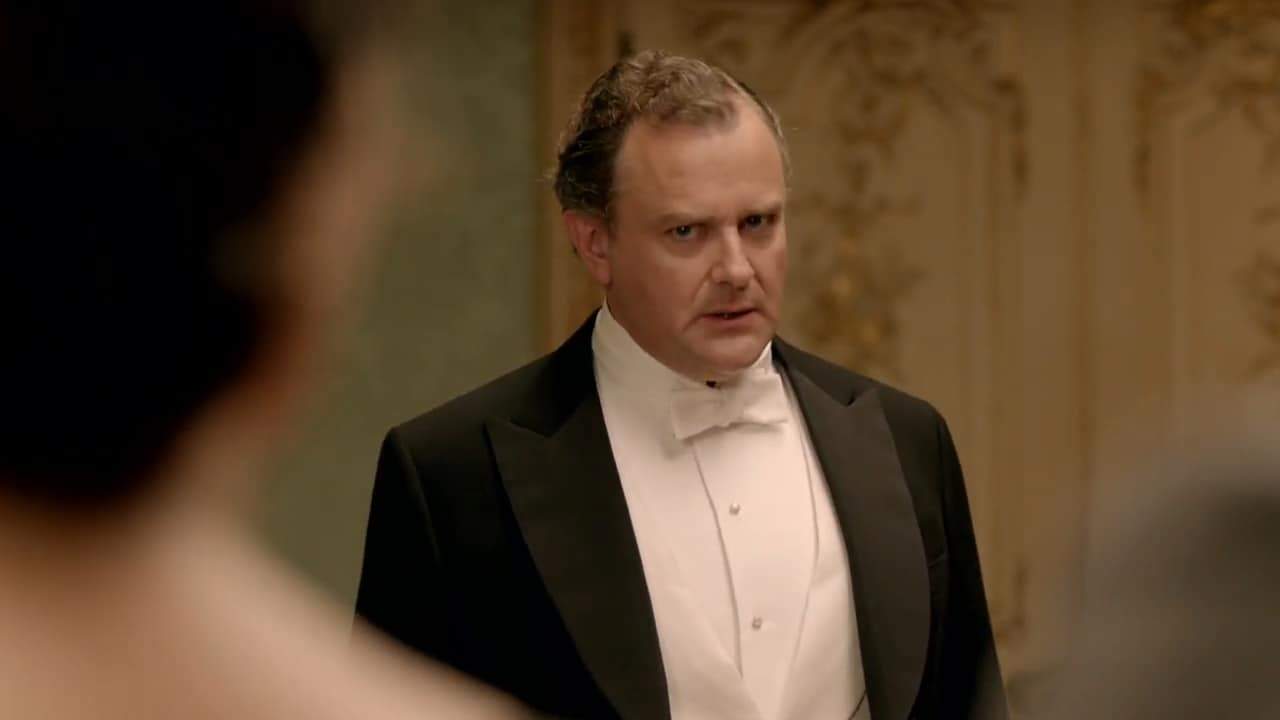
Probably, the most famous evening wear scene of the entire show is when Robert wears a Black Tie dinner jacket for the first time. While, today, a tuxedo or a Black Tie ensemble is the most formal thing most men will ever wear. Back then, it was a step down in formality from the White Tie tailcoat ensemble.
While most Black Tie enthusiasts will probably appreciate the scene, if you take a closer look, for some reason, he’s wearing a soft non-starched shirt, but it doesn’t even have studs.

While it is true that Edward VIII didn’t like those stiff shirts and wanted Black Tie to be worn with softer turn-down collar shirts, he still wore studs.
For some strange reasons, Matthew Crawley’s Black Tie outfits also often show a regular shirt, which is not something he would have worn even with Black Tie. You can see a wide variety of evening colors, though, and it’s nice to see the slightly different details in different characters.
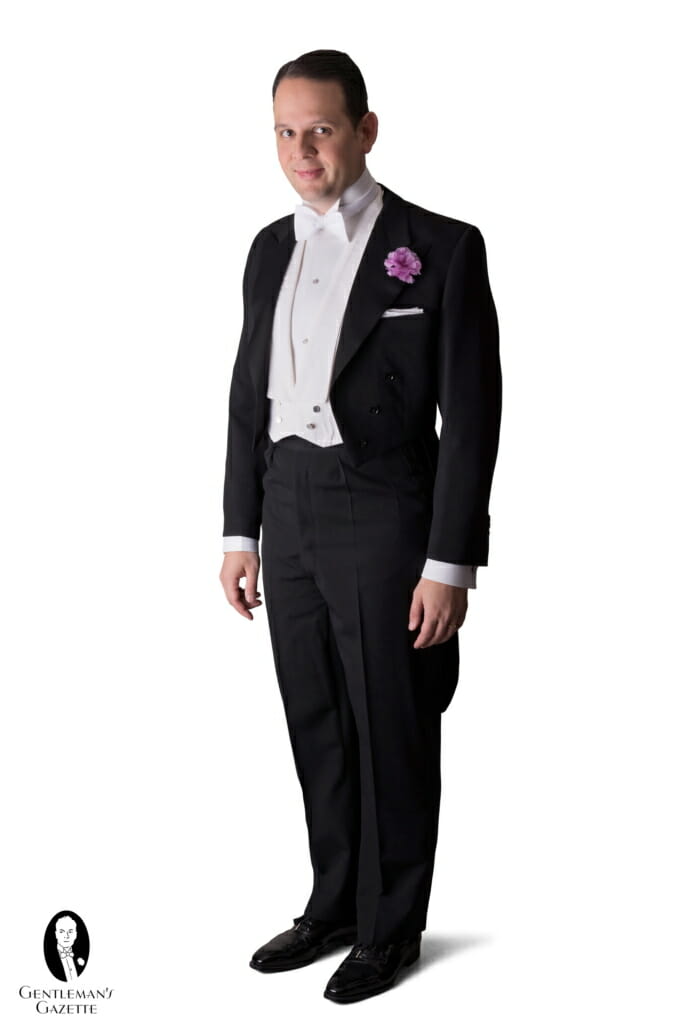
Evening Wear was worn for regular dinners, and you see it frequently throughout the show. In season five, set in 1924, Robert Grantham is still wearing a stiff collar, so he’s obviously a stickler for traditions. In the same event, Tom has a lower collar and the wing is more extreme, which was more comfortable and something favored by a younger generation.
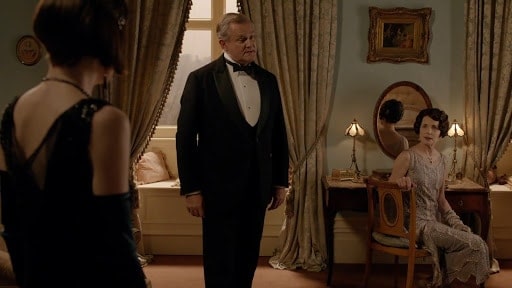
Later on, in season six, which is set in 1925, you can see Lord Grantham wear a butterfly collar, which was a transitional collar to the full wing collar. So, yes, overall, there is some variety. But, other than the collar swap and, maybe, the waistcoat swap, there is not as much variety as we had hoped for.
Hats: 1. Top Hats
Downton Abbey certainly features quite a few hats because back then, everyone wore a hat. First, let’s look at season one, where you can see the Earl of Grantham wearing one hot top hat and George Murray (played by Jonathan Coy) another.

At first glance, they’re both black top hats, but upon closer inspection, you can definitely see there’s a difference in shape. Murray is wearing a shorter top hat that is a bit wider at the top than at the bottom, but it’s more of a 1930s top hat.
Also, look at the brim curl. Murray’s top hat is a lot flatter versus the earl’s, which has much more of a brim curl. Lord Grantham’s top hat is the perfect shape for the period. However, if you look at the material, Murray’s is a lot shinier because they used silk plush.
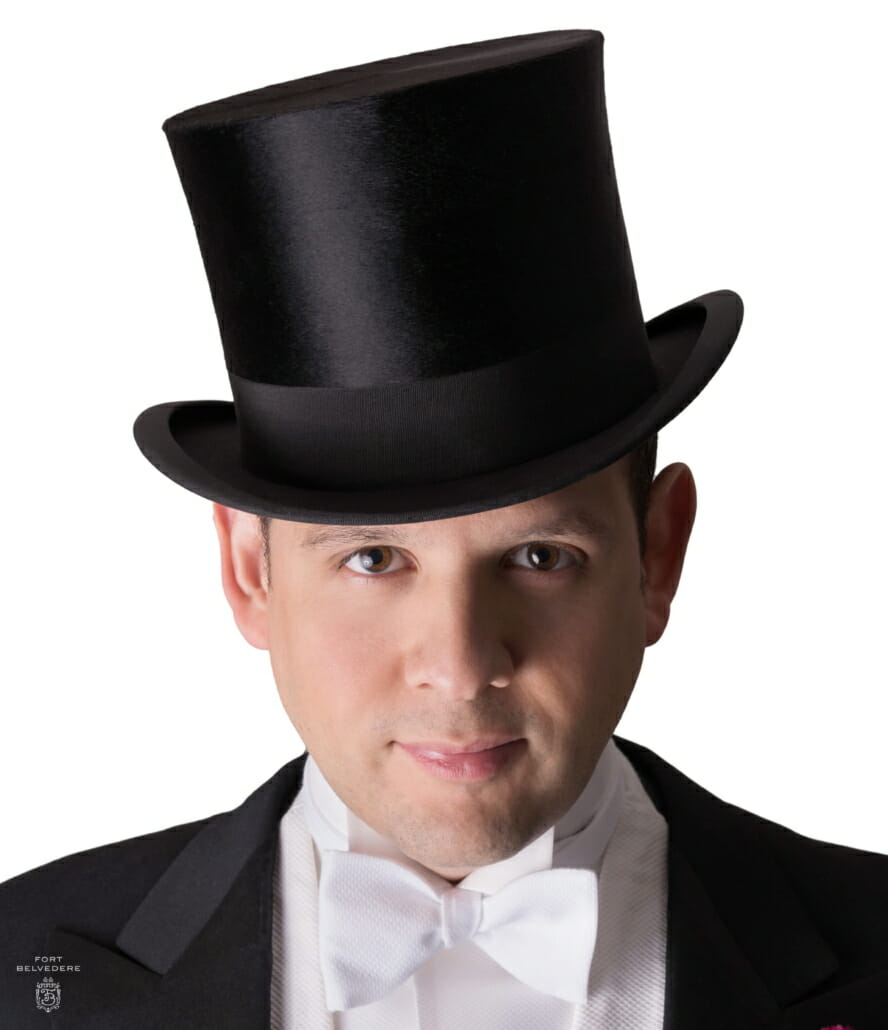
That leads me to believe that Lord Grantham’s top hat is a reproduction and, sadly, silk plush hasn’t been made since the 1960s. And today, nobody knows how to make this material anymore. Typically, modern top hats are made out of a brushed fur felt. They’re just not as shiny, the shapes are not as sharp, and the brim curl is nowhere near what it used to be on older top hats.
2. Fedora Hats
As we step towards the 1920s, we can also see more fedora hats. Lord Grantham can be regularly seen wearing a fedora hat. This style soared in popularity in the UK in the mid-1920s.
However, in a scene set during World War I, the brim is wide, and the head is somewhat floppy. Hats were a little stiffer, and this soft hat style was more reminiscent of 1940s America, not World War I England.
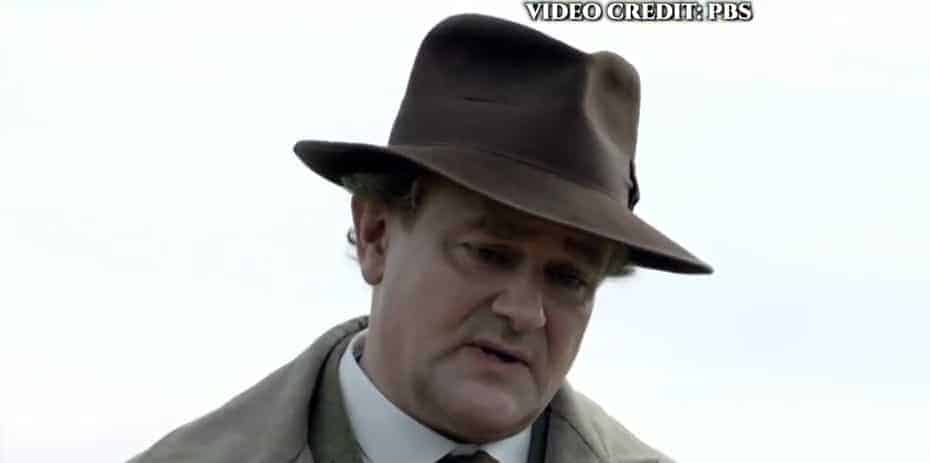
Back then, hats would have been slightly stiffer, and the brim would have had a slightly smaller circumference. Matthew’s fedora probably suffers from the same issue – slightly too floppy, slightly too big. Yes, the fedora was available at the time, but this particular style is not period accurate.
Overall, I’d say the show uses too many fedoras, and they wear them too early. However, in a later episode, you see Bertie Pelham (played by Harry Hadden-Paton) wearing a fedora with a slightly different circumference. And it’s much more period-accurate.

3. Bowler Hat
The bowler hat was typically worn by the middle class as well as the working class. Most of the bowlers in the show seem to be more modern, but you can see them being worn by the valet, Mr. Bates, or by the head butler, Carson.
Carson, who is a staunch traditionalist, also has a hat shape that’s more reminiscent of the 1880s, which is in line with his character because he’s a true royalist and doesn’t like change.

4. Boater Hats
At times, you can also see boater hats being worn in the show, but those are not real vintage boaters. These are soft, floppy versions. They’re definitely modern because true old straw boaters are rather thick and stiff. So, they would either break or look very neat; nothing in between.

An Interesting Menswear Detail: Pleats
Another thing we noticed was pleats. As you might know, personally, I love pleats because I have really big thighs, but Downton Abbey definitely introduced them too early.
In season five, you can see Timothy Drewe (played by Andrew Scarborough) in 1924 wearing pleats. That’s not something that you would have seen at the time. Yes, pleats became more popular in the 30s, but it seems like the show introduced them too quickly and showed too many men wearing them simultaneously. That’s not how it actually was back then.

Conclusion
In case you haven’t watched it yet, definitely do so! Downton Abbey is a great drama, especially if you’re interested in menswear. Overall, yes, they do get a few details wrong. But, in my mind, it’s a lot better than anything usually produced in the US.
Only clothes historians or enthusiasts will probably pick up on the historically inaccurate details, but it really shouldn’t deter you from watching the show.

With all that criticism, you’d probably expect me to sport a perfectly period-accurate 1920s outfit today. However, I don’t have it in my wardrobe. Why? Well, I’m not a reenactor, and my physique doesn’t work with what most men wore back then. I’m just a size or two too large.
That being said, Aaron White, who wrote this script, has a channel called Antique Menswear, and he’s what I would call an Edwardian gentleman who dresses up in true vintage gear. So, if you’re interested in that, check out his YouTube channel.
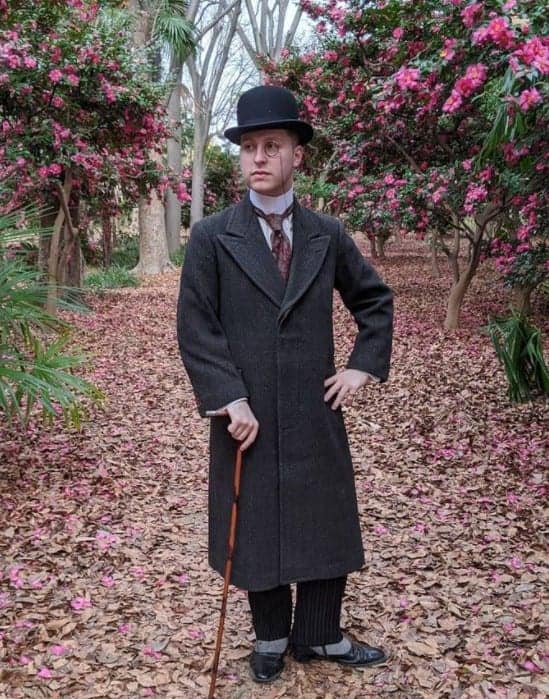
Outfit Rundown
I’m wearing a reddish-brown single-breasted suit that is vintage. I would say maybe late 30s or 40s. It has no vents and three patch pockets, which obviously make it more casual.
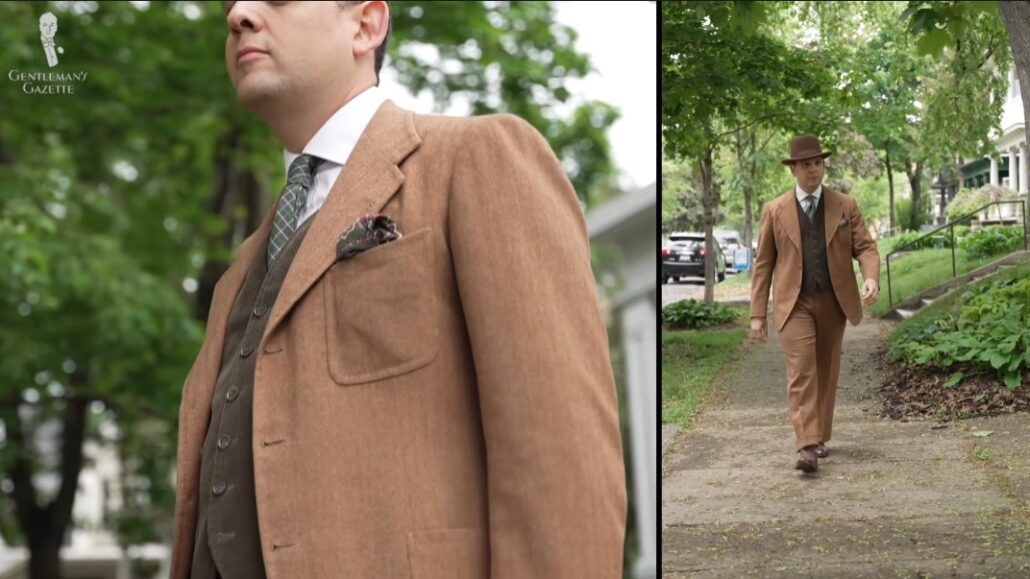
The fabric is heavier and drapes rather nicely. The pants are cut fuller and feature cuffs. I’m pairing it with a more modern waistcoat in green corduroy. And I’m leaving the bottom button undone. The shirt I’m wearing has faint stripes of blue and yellow as a servant would have worn it back then. My tie is a vintage silk and wool tie with a checkerboard diamond pattern in blue, off-white, and green. These colors are picked up by the pocket square from Fort Belvedere, which is also a silk wool pocket square. It’s a little more matte and an all silk pocket square. If you’re interested, you can find it in our shop.
The shirt has French cuffs and I put in a vintage pair of English enamel cufflinks with a nice pattern in blue, which picks up the tones of blue from the tie. The socks are shadow-striped socks from Fort Belvedere that pick up the brown tones and provide enough contrast to the brown Oxford semi-brook shoes. This is something that would also look great with a homburg hat, which I think is better than the fedora hat.
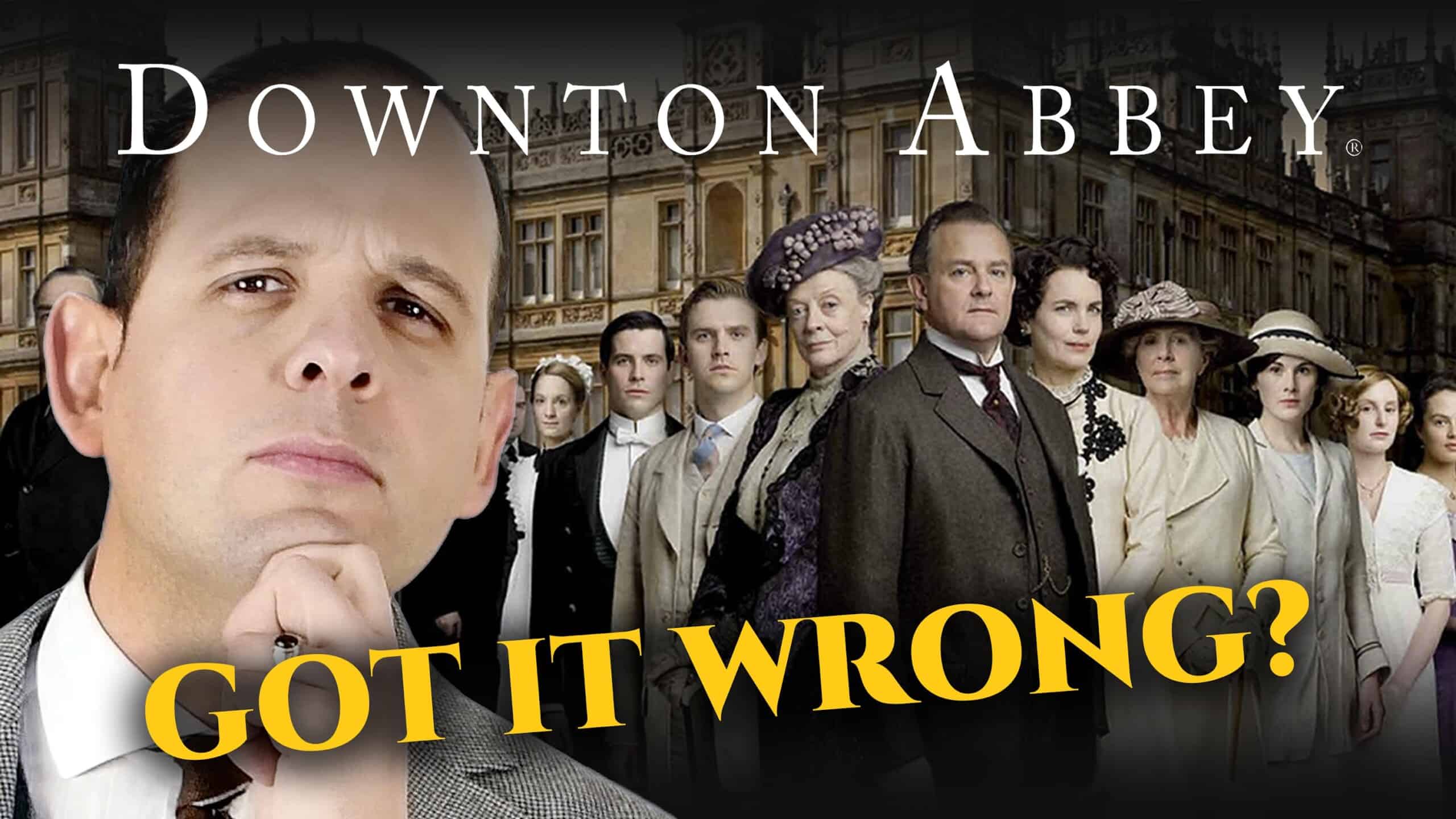

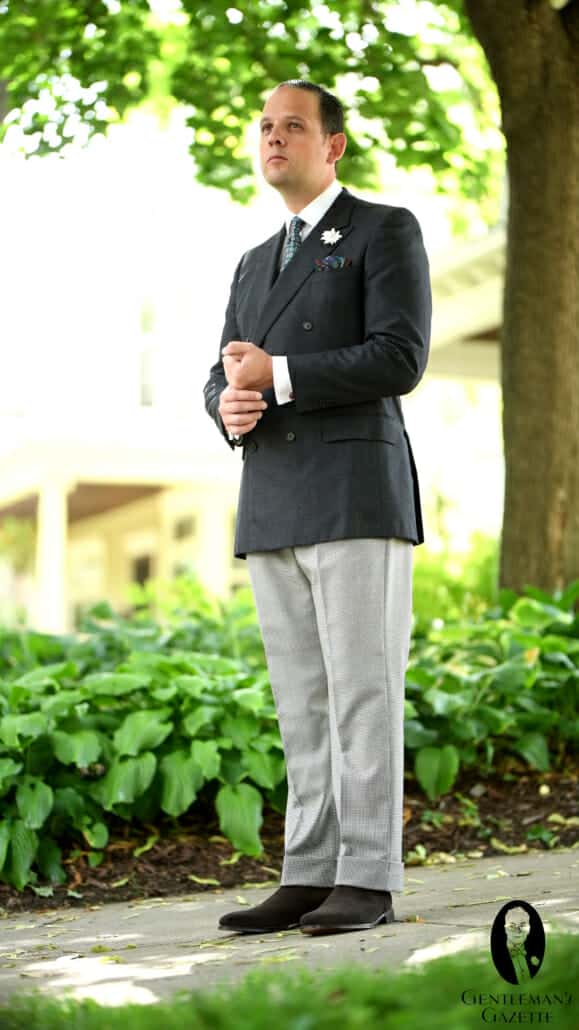
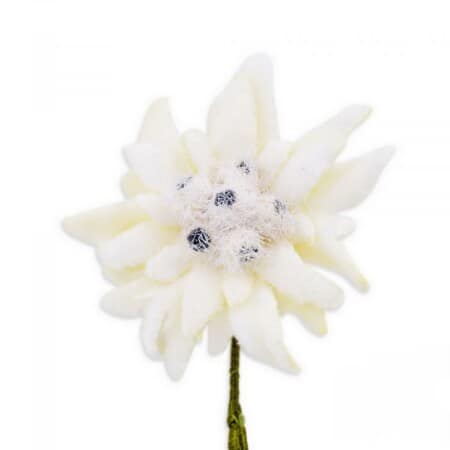
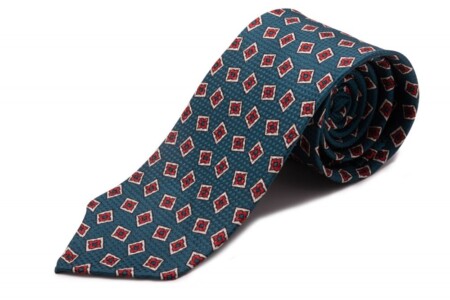
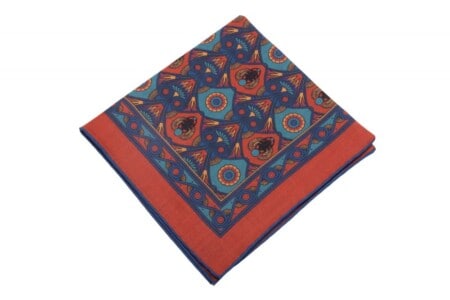
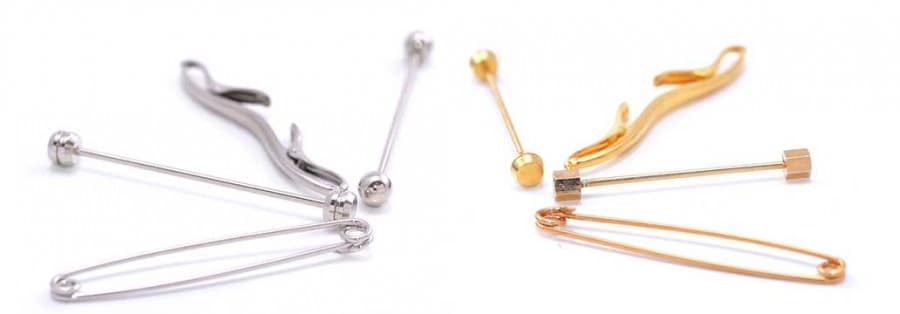
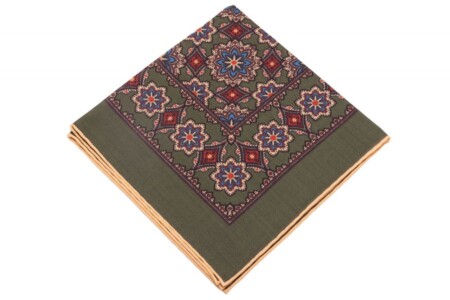
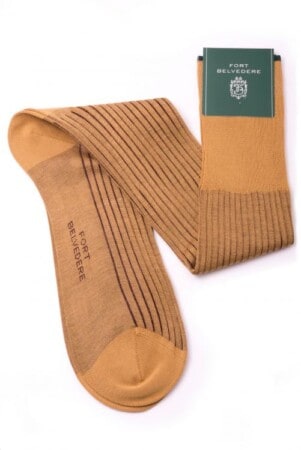
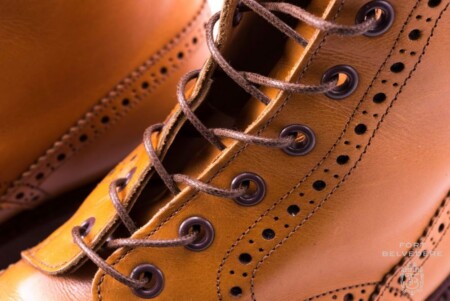
A lovely article which I thoroughly enjoyed.
As a footnote Lord Grantham wore a soft collared shirt the first time in Black Tie because the servants had played a trick on Lord Grantham’s valet and hidden all the formal dinner shirts!
Exactly, I remembered the scene as well when I read the post. In other scenes with black tie he wears appropriate starched bib shirt. I did enjoy the Dowager Countess’s quib on his black tie ensemble asking if next time he would just come to dinner in his pajamas. Black tie was de regeur during the war time years as discussed multiple times on the show. The traditionalists in the show discussed whether white tie as the norm would return with the end of the war. Mr. Carson was quite confident it would, of course.
Unbuttoning the bottom button on a waistcoat is a trend. I don’t think it was ever universal even in this period. It wasn’t considered a faux pas to button the bottom button. And certainly older men might have ignored the trend.
As we pointed out, Bertie introduced it to the world before 1910
I believe the trend started with King George who was to portly to botton the lower bottons of his suit coat and waistcoat.
Which King George? Certainly King George IV would have been portly enough to have done this. Certainly not King George V. I believe that it is generally accepted to that been King Edward VII who was noted for having the lowest button of his waistcoat undone.
Lord Grantham’s fedora is in a style more appropriate for the 1940s than the 1910s…..
NOPE – The Poet (Fedora) is a name the Herbert Johnson brand coined to describe it’s popular classic styles harking back to the early 20th century in England (1895)
Pictures https://herbertjohnson.co.uk/collections/classic-collection/men
They also produce the original fedora for the Indian Jones movies.
Harry Lelieu
Thank you Sven,
For this analysis most interesting and enjoyable (as always). I will take it as an opportunity to watch D. A. a second time…
All the best,
Sven
My wife and I are DA enthusiasts, even to the point of visiting Highclere Castle. I really enjoyed the article. I wish something had been mentioned about flat caps, driving caps, newsboys, etc. as I have a collection of them but don’t know much about their distinguishing characteristics, history, etc.
Hi Jack, very glad to hear you enjoyed the article! If you haven’t already seen it, perhaps this article and accompanying video will help shed some light on your cap collection?
Enjoyed the read and lesson on technical details. The DVDs and now BritBox have the featurettes and one is specifically about the male characters clothing.
Oh! You are such a stuffed shirt. Very good article. For the detailed O.C.D. obsessed.
Great article and video – enjoyable and fascinating. It would be fascinating to see a similar analysis of the clothing worn in the 1970’s PBS Lord Peter Wimsey series (21 episodes with Ian Carmichael). Carmichael and his good friend Patrick Macnee (original 1960’s “Avengers”) both considered themselves menswear aficionados and, it’s rumored, sometimes wore their own clothes on set. The time period covered starts slightly later – I think the earliest we ever see Wimsey is just before the start of WWI in The Nine Tailors. There should nevertheless be a number of points of intersection between the two series.
Thoroughly enjoyed this video. My wife and I are big fans of the show. I always thought the fedoras looked out of place and now I know why. I am just a little disappointed that there wasn’t more attention to detail accuracy, but I am sure it won’t stop my annual summer binge of the show.
I was unaware of the issue of the shoulder seam in suits, that is moving it towards the rear making it less visible from the front. Also I am SO glad that you pronounced it VALET and not VALLAY. Jeeves would have approved!
As for the picture in which Lord Grantham is wearing a normal shirt, all of his shirts went ‘missing’, forcing him to wear a dinner jacket with a soft-collared shirt rather than white-tie (and he was hosting a white-tie gathering too). Also, I believe in one episode, Tom is wearing a pre-tied bow tie, but it’s a bit hard to see (somewhere in season 3, I think. I have no idea if they repeated that). Lovely article as always; I look forward to the next one.
One thing I always noticed while watched Downton Abbey was the lapels on waistcoats (or lack thereof) for the less formal attire. What is the history of that? It’s purely my own bias, but a visible waistcoat sans lapels just has a more modern look to me – like it is unfinished and deliberately trying to be sleek in a late 1990s sort of way. I would especially expect lapels on the waistcoats for “country” attire such as tweed, or odd jackets in general.